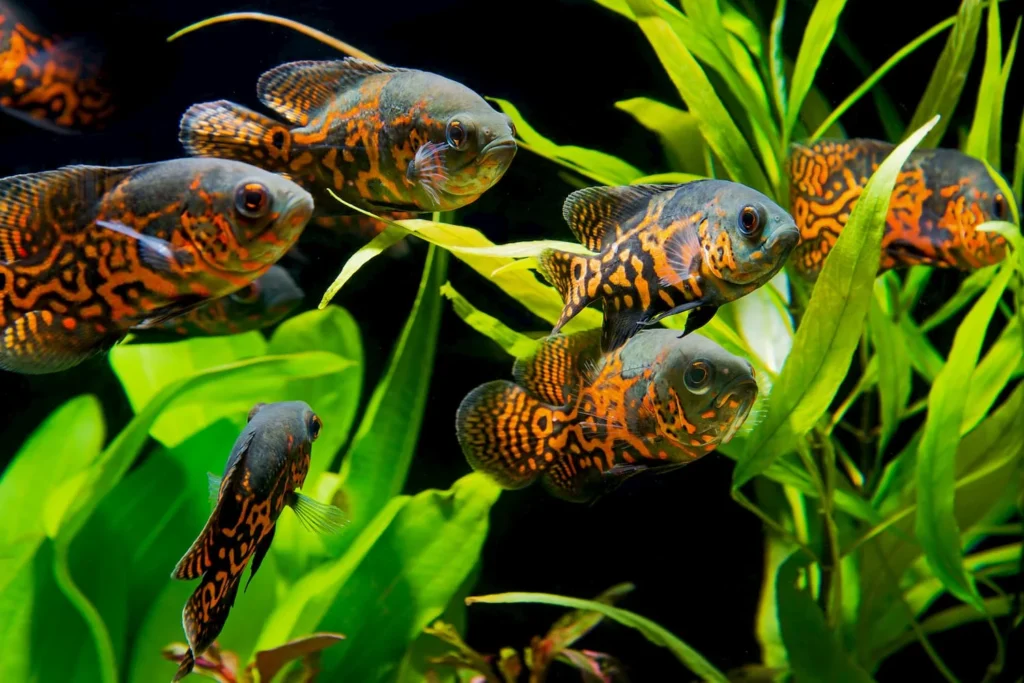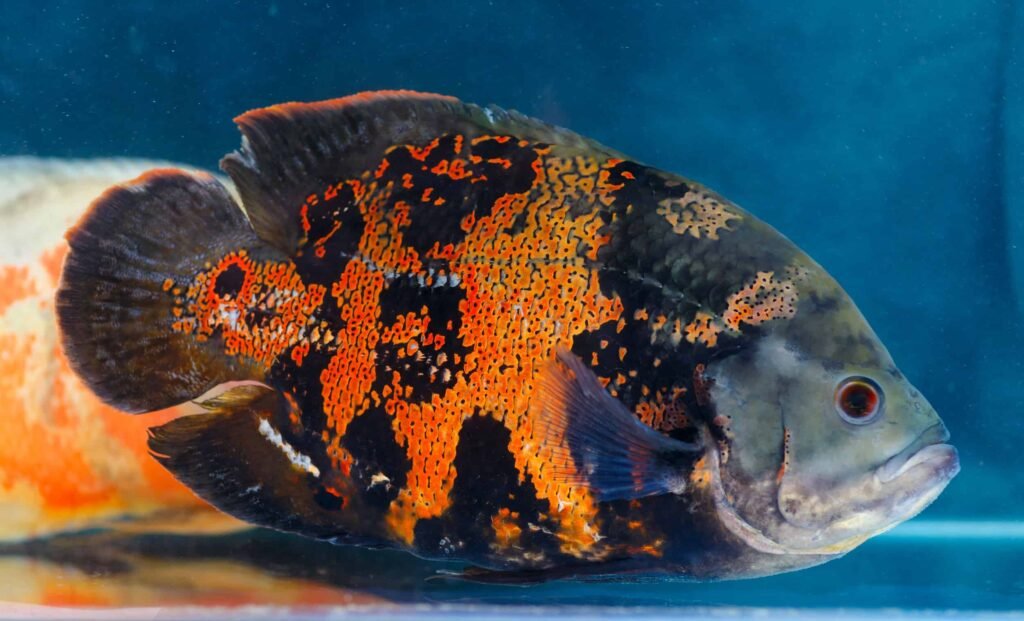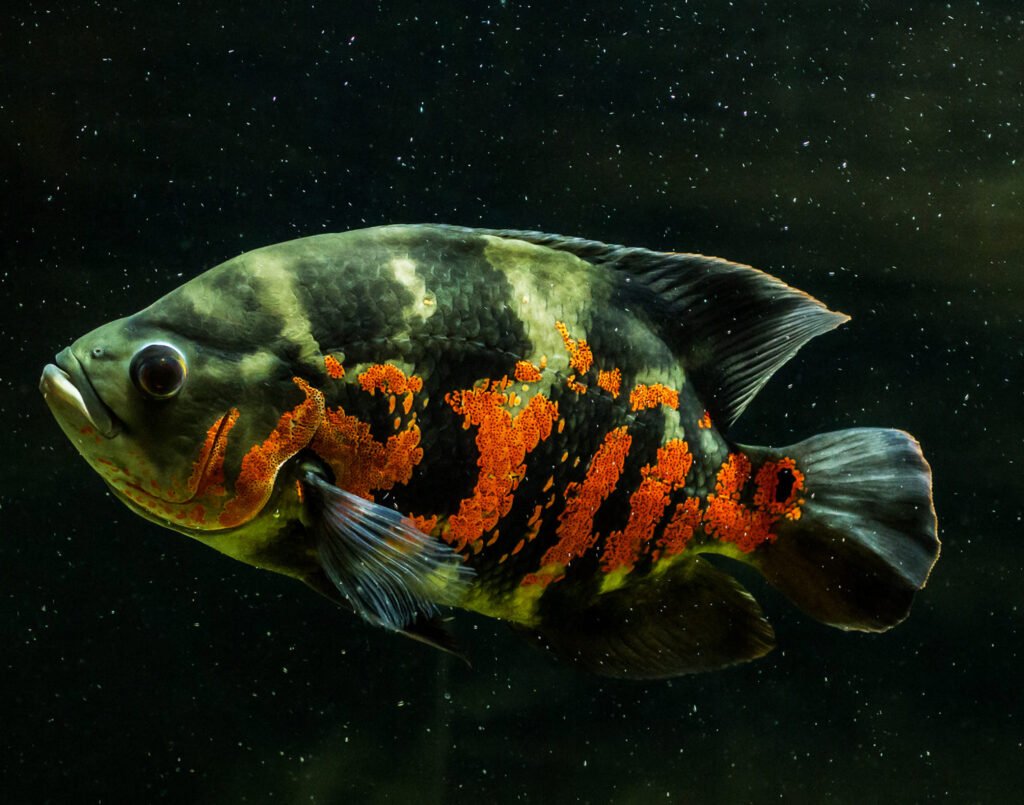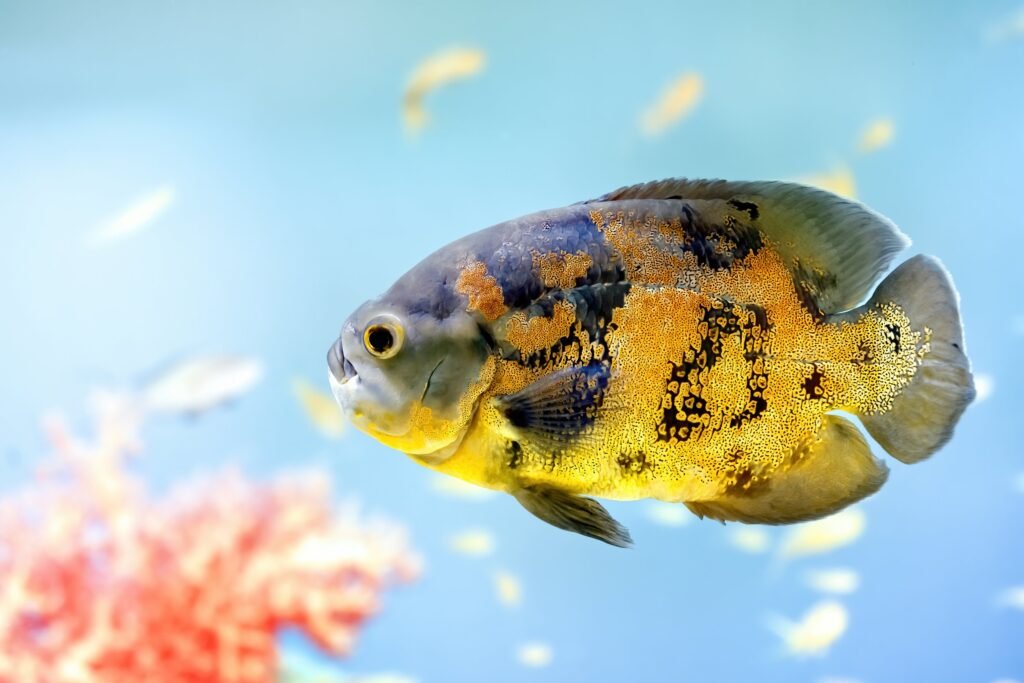Oscar Fish: Unraveling the Secrets of These Vibrant and Intelligent Aquatic Titans

Oscar Fish: Unraveling the Secrets of These Vibrant and Intelligent Aquatic Titans
Oscar Fish: The Ultimate Guide to Keeping These Majestic Aquatic Gems
Quick Facts
Scientific Name: Astronotus ocellatus
Common Names: Oscar, tiger oscar, velvet cichlid
Origin: Amazon River basin in South America, including Brazil, Colombia, and Peru
Adult Size: 10 to 14 inches (25 to 35 cm) in length, with some individuals reaching up to 18 inches (45 cm)
Lifespan: 10 to 20 years or more with proper care
Tank Size: Minimum 75 gallons (284 liters) for a single fish, with 125 gallons (473 liters) or larger being optimal
Diet: Omnivorous, requiring a varied diet of pellets, live or frozen foods, and vegetables
Temperament: Generally peaceful, but can be territorial and aggressive towards smaller or weaker tank mates
Difficulty: Intermediate, due to their size and specific water requirements
Introduction
When it comes to impressive freshwater fish, few can match the majesty and allure of the Oscar. With their striking colors, bold patterns, and larger-than-life personalities, these South American cichlids have captured the hearts of aquarists around the world, earning a place of honor in the pantheon of aquarium royalty.
Native to the slow-moving rivers and floodplains of the Amazon basin, Oscars have evolved to thrive in the warm, murky waters of their homeland. These powerful predators can grow to impressive sizes, with some individuals reaching lengths of 18 inches (45 cm) or more in captivity. But despite their imposing stature, Oscars are known for their gentle giants’ demeanor, displaying a curious and intelligent nature that has endeared them to fish keepers for generations.
The story of the Oscar’s rise to aquarium stardom is a fascinating one, filled with twists, turns, and a healthy dose of serendipity. In the early 20th century, an enterprising fish collector named Manuel Rabaut stumbled upon a group of Oscars while exploring the Amazon basin. Struck by their beauty and potential, Rabaut brought a few specimens back to the United States, where they quickly gained a reputation as hardy, adaptable fish with a knack for winning over even the most skeptical aquarists.
As word of the Oscar’s charms spread, demand for these remarkable cichlids skyrocketed. Breeders and hobbyists alike raced to unlock the secrets of Oscar care and reproduction, developing new techniques and varieties that pushed the boundaries of what was thought possible. Today, Oscars are available in a dazzling array of colors and patterns, from the classic tiger-striped wild type to the vibrant red, albino, and lemon morphs that grace aquariums around the world.
But the Oscar’s popularity isn’t just about good looks. These intelligent fish have a way of worming their way into the hearts of their keepers, forming bonds that blur the line between pet and companion. Oscars have been known to recognize their owners, beg for food like puppy dogs, and even perform tricks on command. Some aquarists swear that their Oscars have unique personalities, complete with quirks, preferences, and moods that shift with the tides.
Of course, keeping an Oscar is not without its challenges. These large, messy fish require spacious accommodations, top-notch filtration, and a carefully curated diet to thrive. They can also be territorial and destructive, rearranging decor and bullying smaller tank mates with gleeful abandon. But for those who are willing to put in the time, effort, and occasional elbow grease, the rewards of Oscar ownership are immeasurable.
In this guide, we’ll take a deep dive into the world of Oscar care, covering everything from tank setup and water chemistry to nutrition and common health issues. We’ll explore the history and varieties of these aquatic gems, share tips and tricks from seasoned Oscar keepers, and even delve into the joys and challenges of breeding these magnificent fish. So sit back, grab a snack (preferably not an Oscar pellet), and get ready to discover the wonders of life with an Oscar fish.
The Many Faces of Oscar Fish
One of the things that makes Oscars so endlessly fascinating is the sheer variety of colors and patterns they come in. While the classic “wild-type” Oscar is a sight to behold, with its rich, tiger-like striping and iridescent scales, it’s just the tip of the proverbial iceberg when it comes to Oscar diversity.
Over the years, dedicated breeders have worked tirelessly to develop new and exciting Oscar morphs, each with its own unique look and personality. Some of the most popular and sought-after varieties include:
Red Oscar: As the name suggests, red Oscars are a vibrant, eye-catching morph with deep, scarlet-hued scales that seem to glow from within. These fish are often called “cherry Oscars” or “ruby Oscars,” and they’re a favorite among those who appreciate a pop of color in their aquarium.
Albino Oscar: Albino Oscars are a striking contrast to their wild-type cousins, with pale, almost translucent scales and bright red eyes. These fish lack the pigment melanin, which gives other Oscars their darker coloration, resulting in a ghostly, ethereal appearance that’s sure to turn heads.
Tiger Oscar: Tiger Oscars are the quintessential Oscar morph, with bold, black stripes set against a rich, orange-brown background. These fish are often considered the “classic” Oscar look, and they’re a favorite among those who appreciate a more natural, wild-caught aesthetic.
Lemon Oscar: Lemon Oscars, as you might guess, are a bright, cheery yellow color that’s sure to bring a smile to your face. These sunny fish are a relatively new addition to the Oscar family, but they’ve quickly become a favorite among those who love a splash of citrus in their tank.
Veil Tail Oscar: Veil tail Oscars are a unique morph that features elongated, flowing fins that trail behind them like a bridal veil. These elegant fish are a stunning sight to behold, with their graceful, undulating movements and shimmering scales.
Of course, these are just a few of the many Oscar varieties out there. From the spotted “starry night” Oscar to the marbled “calico” Oscar, there’s an endless array of colors, patterns, and fin types to choose from. And with new morphs being developed all the time, the possibilities are truly limitless.
But no matter which Oscar variety you choose, one thing is certain: you’re in for a treat. These fish are more than just pretty faces; they’re intelligent, curious creatures with a zest for life that’s impossible to resist. So whether you’re drawn to the classic stripes of a tiger Oscar or the otherworldly glow of an albino, you can rest assured that your Oscar will be a beloved and fascinating addition to your aquatic family.
Creating the Ultimate Oscar Oasis
If you’re serious about keeping Oscars, the first and most important step is to create a tank setup that caters to their unique needs and preferences. These large, active fish require plenty of space to swim, explore, and stake out their territory, so a big, well-equipped aquarium is an absolute must.
When it comes to tank size, bigger is always better where Oscars are concerned. A single adult Oscar will need at least a 75-gallon (284-liter) aquarium, but if you’re planning on keeping a pair or a group, you’ll want to go even larger. A 125-gallon (473-liter) tank or bigger is ideal for multiple Oscars, providing plenty of room for everyone to spread out and do their thing.
Once you’ve got your tank, the next step is to choose a substrate that’s both functional and visually appealing. Many Oscar keepers prefer a natural-looking substrate like sand or fine gravel, which can help to mimic the riverbed habitats where Oscars live in the wild. However, if you’re planning on keeping live plants, you may want to opt for a nutrient-rich substrate like aquarium soil or clay to help them thrive.
When it comes to decor, Oscars are all about the “more is more” philosophy. These curious fish love to explore every nook and cranny of their tank, so providing plenty of hiding spots, caves, and other structures is key to keeping them happy and engaged. Driftwood, rocks, and even terracotta pots can all make great additions to an Oscar tank, giving your fish plenty of places to hide, sleep, and stake out their territory.
Of course, no Oscar tank would be complete without some live plants to round things out. Not only do plants help to create a more natural, visually appealing environment, but they also provide important benefits like oxygenation, nutrient absorption, and even a bit of snacking material for your Oscars. Some great plant options for Oscar tanks include hardy, fast-growing species like Amazon swords, Java fern, and Anubias.
But the real key to creating the ultimate Oscar oasis is filtration. These big, messy fish produce a lot of waste, and without a top-notch filtration system to keep things in check, your tank can quickly turn into a murky, smelly mess. A high-quality canister filter or sump system is a must for any serious Oscar keeper, providing the mechanical, biological, and chemical filtration needed to keep your water crystal-clear and your fish healthy and happy.
When it comes to water parameters, Oscars are pretty adaptable, but they do have some specific requirements that you’ll need to keep in mind. These fish prefer warm, slightly acidic to neutral water with a pH between 6.0 and 8.0 and a temperature range of 75-80°F (24-27°C). They also appreciate a moderate to high level of water hardness, with a dGH between 5-20 and a dKH between 5-15.
To maintain these parameters, you’ll need to perform regular water changes of 10-25% per week, depending on your tank size and bioload. You’ll also want to invest in a good water test kit and keep a close eye on your ammonia, nitrite, and nitrate levels, as well as your pH and hardness. If any of these parameters start to drift out of range, you’ll need to take action quickly to get things back on track.
With the right setup and maintenance, your Oscar tank can be a true oasis – a peaceful, thriving ecosystem that showcases the beauty and brilliance of these amazing fish. So roll up your sleeves, grab your nets, and get ready to create the ultimate Oscar paradise!
The Oscar Diet: Feeding Your Aquatic Gourmand
When it comes to feeding Oscars, the old adage “variety is the spice of life” definitely applies. These omnivorous fish have big appetites and a taste for just about anything that fits in their mouths, from meaty proteins to fresh veggies and everything in between.
In the wild, Oscars are opportunistic feeders that will chow down on a wide range of prey, including smaller fish, crustaceans, insects, and even the occasional fruit or seed that falls into the water. As aquarium residents, they require a similarly diverse and nutritious diet to thrive, with a mix of high-quality dry foods, frozen or live foods, and fresh produce rounding out the menu.
When it comes to staple foods, a good quality cichlid pellet or flake should form the backbone of your Oscar’s diet. Look for brands that are specifically formulated for large, carnivorous fish, with plenty of protein, fat, and essential vitamins and minerals to support healthy growth and development. Aim to feed your Oscar two to three times per day, offering only as much food as they can consume in a few minutes to avoid overfeeding and water quality issues.
To add some variety and excitement to your Oscar’s diet, consider incorporating frozen or live foods like brine shrimp, bloodworms, krill, and even the occasional feeder fish (though be sure to quarantine these first to avoid introducing diseases to your tank). These meaty treats are a great way to satisfy your Oscar’s predatory instincts and provide a boost of extra protein and nutrition.
But man cannot live on meat alone, and neither can Oscars! To round out their diet and provide some essential fiber and nutrients, be sure to offer your fish a selection of fresh veggies like blanched spinach, zucchini, and even the occasional piece of fruit like a mango or papaya chunk. Some Oscars may need some coaxing to try these green and fruity treats, but once they get a taste, they’ll likely be begging for more.
Of course, every Oscar is different, and what works for one fish may not work for another. Some Oscars may have specific dietary needs or preferences, such as a sensitivity to certain proteins or a love of a particular veggie. As an Oscar keeper, it’s your job to observe your fish closely and adjust their diet as needed to keep them healthy, happy, and thriving.
One important thing to keep in mind when feeding Oscars is their size and growth potential. These fish can put on a lot of bulk in a short amount of time, especially when they’re young and growing fast. To avoid overfeeding and obesity, be sure to monitor your Oscar’s body condition closely and adjust their portion sizes as needed. A good rule of thumb is to offer an amount of food that’s roughly the size of your Oscar’s eye, two to three times per day.
With a varied, nutritious diet and a watchful eye, you can help your Oscar reach their full potential as the king or queen of the aquarium. So get creative, have fun, and bon appétit to your aquatic gourmand!
Oscar Health and Wellness: Keeping Your Fish in Tip-Top Shape
Like any living creature, Oscars are susceptible to a variety of health issues and illnesses that can impact their quality of life and even threaten their survival. As an Oscar keeper, it’s your job to be vigilant about your fish’s health and take proactive steps to prevent and treat any problems that may arise.
One of the most common health issues in Oscars is hole-in-the-head disease, also known as hexamita. This condition is caused by a protozoan parasite that attacks the fish’s skin and organs, causing lesions and ulcers to form on the head and body. Hole-in-the-head can be difficult to treat once it takes hold, so prevention through good water quality, a balanced diet, and regular tank maintenance is key.
Another issue that can plague Oscars is ich, or white spot disease. This highly contagious condition is caused by a ciliated protozoan that attaches to the fish’s skin and gills, causing irritation and making it difficult for the fish to breathe. Ich can be treated with a combination of heat, salt, and medication, but it’s important to catch it early and quarantine any affected fish to prevent it from spreading to the rest of your tank.
Other common health issues in Oscars include fin rot, fungal infections, and swim bladder disease, all of which can be caused by poor water quality, stress, or a compromised immune system. To keep your Oscar in tip-top shape, it’s important to maintain excellent water parameters, provide a balanced and nutritious diet, and keep a close eye out for any signs of illness or distress.
One of the best ways to prevent health issues in Oscars is to perform regular tank maintenance and water changes. Oscars are messy fish that produce a lot of waste, and without proper filtration and cleaning, that waste can quickly build up and create an unhealthy environment for your fish. Aim to perform a 10-25% water change once a week, using a gravel vacuum to remove any debris and uneaten food from the substrate.
Another important aspect of Oscar health is providing them with a stress-free environment. Oscars are sensitive fish that can easily become stressed by sudden changes in their environment, such as temperature fluctuations, loud noises, or aggressive tank mates. To minimize stress, be sure to acclimate your Oscar slowly to any new tank or water conditions, provide plenty of hiding spots and territories, and avoid overcrowding or housing them with incompatible species.
If you do notice any signs of illness or distress in your Oscar, it’s important to act quickly and seek professional help if needed. Many common health issues can be treated with over-the-counter medications or simple changes to your tank setup, but more serious conditions may require the intervention of a veterinarian or experienced fish keeper. Don’t be afraid to reach out to the Oscar community for advice and support – there are many knowledgeable and helpful folks out there who are more than happy to lend a hand.
With proper care, a healthy environment, and a watchful eye, your Oscar can thrive for many years to come. So keep those water parameters in check, those veggies coming, and those fins flapping – your Oscar will thank you for it!
As we’ve seen throughout this guide, Oscar fish are truly one of a kind. From their striking appearance and impressive size to their curious personalities and voracious appetites, these South American cichlids have captured the hearts and imaginations of aquarists around the world.
Keeping Oscars can be a challenging but immensely rewarding experience, one that requires dedication, patience, and a willingness to go the extra mile for your finned friends. These fish are not for the faint of heart or the casual hobbyist – they demand time, space, and attention to thrive, and they’re not afraid to let you know when they’re not happy.
But for those who are up to the task, the joys of Oscar ownership are truly unparalleled. Watching these majestic creatures grow from tiny, striped juveniles to massive, colorful adults is a journey like no other, filled with surprises, laughs, and moments of pure wonder. Oscars have a way of worming their way into your heart and becoming more than just pets – they’re members of the family, each with their own unique personality and quirks.
Of course, keeping Oscars is not without its challenges. These fish are messy, hungry, and sometimes destructive, and they require a level of care and maintenance that can be daunting for even experienced aquarists. But with the right setup, diet, and attention to detail, the rewards of Oscar ownership far outweigh the difficulties.
In the end, keeping Oscars is about more than just having a pretty fish in a tank. It’s about forming a bond with a living, breathing creature that depends on you for its health and happiness. It’s about creating a slice of the Amazon in your own home, a vibrant ecosystem that showcases the beauty and diversity of the natural world. And it’s about being a part of a community of like-minded enthusiasts who share your passion for these incredible fish.
So whether you’re a seasoned Oscar keeper or a wide-eyed newbie, we hope this guide has inspired you to take the plunge and discover the joys of life with an Oscar. Trust us – it’s a journey you won’t regret.
As we wrap up this epic Oscar odyssey, we want to leave you with a few parting words of wisdom. First and foremost, always prioritize the health and well-being of your fish above all else. Oscars are living creatures with complex needs and emotions, and it’s up to us as their keepers to provide them with the best possible care and quality of life.
Secondly, never stop learning and growing as an aquarist. The world of Oscars is vast and ever-evolving, with new discoveries, techniques, and challenges emerging all the time. Stay curious, stay humble, and never be afraid to ask for help or advice when you need it.
And finally, remember to have fun! Keeping Oscars can be a lot of work, but it should also be a source of joy, wonder, and fulfillment. Take the time to appreciate the little moments – the silly antics, the gluttonous feeding frenzies, the peaceful naps in the afternoon sun. These are the memories that will stay with you long after the water changes and filter cleanings have faded away.
So here’s to you, dear Oscar keeper. May your tanks be clear, your fish be happy, and your heart be full of the magic and marvel of these truly incredible creatures. Keep on swimming!

Oscar fish, Astronotus ocellatus, South American cichlids, Amazon River basin, aquarium fish, freshwater fish, large cichlids, cichlid tank, Oscar tank setup, Oscar care, Oscar diet, Oscar feeding, Oscar health, Oscar disease prevention, hole-in-the-head disease, ich, fin rot, water quality, tank maintenance, Oscar breeding, Oscar varieties, tiger Oscar, red Oscar, albino Oscar, veil tail Oscar, lemon Oscar, Oscar tank mates, peaceful cichlids, aggressive cichlids, omnivorous fish, aquarium filtration, aquarium lighting, aquarium heating, water changes, stress reduction, fish behavior, fish personality, aquarium hobby, fishkeeping, cichlid enthusiasts, Oscar community, fish bond, aquatic ecosystem, natural world.
“Oscar Fish: The Majestic Titans of the Aquarium World”
Views: 5












